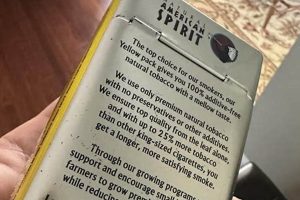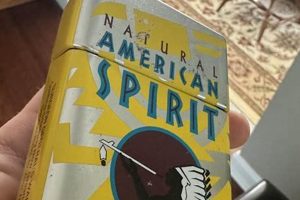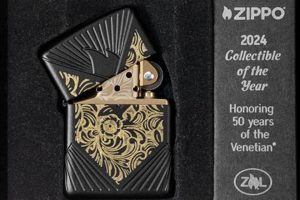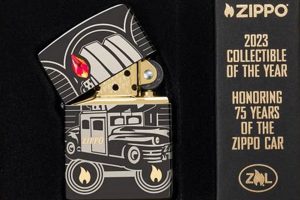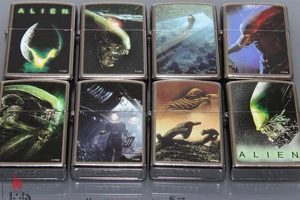Pocket lighters bearing the Boy Scouts of America emblem, often produced by Zippo, are sought-after items for collectors. These items can range from standard production models with the logo to limited edition releases commemorating specific jamborees or anniversaries. An example would be a chrome Zippo lighter featuring the Universal Emblem of the Boy Scouts of America against a background depicting the organization’s values.
These lighters represent more than just a fire-starting tool; they embody a piece of Scouting history and tradition. They serve as tangible reminders of outdoor adventures, camaraderie, and the values instilled by the organization. For collectors, these items hold historical significance, connecting them to a larger community and preserving a piece of Americana. Their value can fluctuate depending on rarity, condition, and historical context. Furthermore, these collectibles can be a starting point for conversations about the history and impact of Scouting.
This exploration will delve into the specifics of various models, their production history, factors influencing their collectibility, and tips for identifying authentic pieces. It will also examine the broader market for Scouting memorabilia and its connection to the organization’s enduring legacy.
Tips for Collecting Scouting-Themed Pocket Lighters
Acquiring Scouting memorabilia requires careful consideration to ensure authenticity and value. The following tips offer guidance for collectors at all levels of experience.
Tip 1: Authentication is Key: Scrutinize potential purchases for hallmarks of genuine Zippo lighters. Examine the bottom stamp for date codes and compare them with known production periods. Counterfeit items often lack the precise details and craftsmanship of originals.
Tip 2: Condition Matters: A lighter’s condition significantly impacts its value. Look for minimal wear, scratches, or dents. The original box and accompanying paperwork also enhance desirability.
Tip 3: Research Specific Models: Certain limited edition releases or commemoratives command higher prices. Understanding the historical context and production numbers of specific models will inform purchasing decisions.
Tip 4: Consult Reputable Dealers: Established dealers specializing in Scouting memorabilia or Zippo lighters can provide valuable expertise and authenticate items. They can also offer insights into market trends and pricing.
Tip 5: Join Collector Communities: Online forums and collector groups offer opportunities to connect with other enthusiasts, share knowledge, and discover rare or undervalued items.
Tip 6: Proper Storage Preserves Value: Protect lighters from extreme temperatures and humidity. Displaying them in protective cases can prevent damage and maintain their condition.
Tip 7: Patience is a Virtue: Building a valuable collection takes time and effort. Avoid impulsive purchases and focus on acquiring items that align with specific collecting goals.
By following these guidelines, collectors can build meaningful collections while mitigating risks and maximizing the long-term value of their acquisitions. These practices contribute to the preservation of Scouting history and the enjoyment of these unique collectibles.
This information provides a foundation for making informed decisions about acquiring and preserving these pieces of Scouting history. The subsequent sections will explore specific examples of notable models and their significance within the broader context of Scouting memorabilia.
1. Historical Significance
The historical significance of a Boy Scouts collectible Zippo lighter stems from its connection to the organization’s rich history and traditions. These lighters serve as tangible artifacts, reflecting specific eras, events, and values within the Scouting movement. Understanding this historical context adds depth to the appreciation and value of these collectibles.
- Commemorative Editions:
Many collectible lighters commemorate specific National or World Jamborees, significant anniversaries of the Boy Scouts of America, or other noteworthy events. These editions often feature unique designs and markings related to the commemorated occasion, providing a direct link to a specific moment in Scouting history. For example, a lighter celebrating the 1981 National Jamboree at Fort A.P. Hill, Virginia, connects the owner to that event and the Scouts who attended.
- Evolution of Design and Logos:
Examining lighters from different periods reveals the evolution of the Boy Scouts’ visual identity. Changes in logos, slogans, and design aesthetics reflect broader cultural shifts and the organization’s evolving image. A collection spanning several decades can illustrate these transformations, offering a visual timeline of Scouting’s history.
- Connection to Scouting Values:
Certain lighter designs incorporate elements representing core Scouting values, such as preparedness, service, and outdoor skills. These designs reinforce the organization’s principles and serve as reminders of the ideals instilled in Scouts throughout generations. A lighter featuring the trefoil emblem, for example, symbolizes the three parts of the Scout Oath.
- Reflection of Social and Cultural Context:
Collectible lighters, like other historical artifacts, can reflect the social and cultural context of their time. Manufacturing techniques, popular design motifs, and even the materials used can offer insights into the era in which the lighter was produced. This adds another layer of historical significance beyond the Scouting context itself.
By exploring these facets, collectors gain a deeper appreciation for the historical significance embedded within these seemingly simple objects. Each lighter tells a story, connecting the present with the past and preserving a tangible piece of Scouting’s enduring legacy.
2. Rarity and Condition
The value of a Boy Scouts collectible Zippo lighter is significantly influenced by its rarity and condition. These two factors are intertwined, with rarer items often commanding higher prices, especially when preserved in excellent condition. Understanding how rarity and condition interact is crucial for collectors seeking to assess and maintain the value of their acquisitions.
- Limited Production Runs:
Lighters produced in limited quantities, such as those commemorating specific events or anniversaries with a fixed production number, are inherently rarer. For instance, a lighter released for a National Jamboree with a production run of only 500 will be considerably more valuable than a standard production model. The lower the production number, the higher the potential value, assuming comparable condition.
- Prototype or Pre-Production Models:
Prototypes and pre-production samples, created during the design and development phase, are exceptionally rare. These lighters often exhibit slight variations from the final production model and provide a glimpse into the manufacturing process. Their scarcity makes them highly desirable among collectors, often commanding premium prices.
- Factors Affecting Condition:
Condition encompasses various factors, including the presence of scratches, dents, or tarnish. The lighter’s functionality also plays a role, with working flints and wicks contributing to its overall condition. Unused lighters, especially those retaining their original packaging and paperwork, are generally more valuable than those showing signs of wear. Environmental factors like humidity and exposure to extreme temperatures can also negatively impact a lighter’s condition over time.
- Grading Systems:
Standardized grading systems exist for assessing the condition of collectible lighters, often using a numerical or descriptive scale. These systems provide a common language for collectors and dealers to communicate about a lighter’s condition, facilitating more accurate valuations. Familiarizing oneself with these grading systems helps collectors assess a lighter’s condition objectively and make informed purchasing decisions.
The interplay between rarity and condition ultimately determines a Boy Scouts collectible Zippo lighter’s market value. A rare lighter in poor condition might be less valuable than a common lighter in pristine condition. Therefore, collectors must carefully evaluate both factors to understand an item’s true worth and potential for appreciation. Preserving a lighter’s condition through proper storage and handling is essential for maintaining its value over time and contributing to its long-term collectibility within the Scouting memorabilia market.
3. Edition Variations
Edition variations are central to the collectibility of Boy Scouts Zippo lighters. These variations, stemming from specific design choices during production, establish a hierarchy of desirability among collectors. Understanding these variations is essential for navigating the market and appreciating the nuances that distinguish one collectible lighter from another.
Several factors contribute to edition variations. Commemorative releases often feature unique engravings or artwork related to a specific Jamboree, anniversary, or historical event. Variations in base metal finisheschrome, brushed chrome, brass, or sterling silvercan also distinguish different editions. Limited edition runs, often numbered, create inherent scarcity and add to collectible value. Even subtle changes in logo design or placement can contribute to a distinct edition variation. For example, a lighter commemorating the 1977 National Jamboree might feature the event’s logo and location, distinguishing it from standard production models. Similarly, a lighter produced for the Order of the Arrow, a Scouting honor society, will incorporate its distinctive arrow and torch symbol. These variations establish clear delineations between editions and enhance their appeal to specialized collectors.
Recognizing edition variations provides practical benefits for collectors. It enables informed decision-making during acquisition, allowing collectors to focus on specific variations that align with their interests. This knowledge empowers collectors to identify undervalued items and anticipate potential market trends. Moreover, understanding edition variations allows collectors to appreciate the subtle details and historical context associated with each lighter, enhancing the overall collecting experience. Ultimately, recognizing edition variations is crucial for building a comprehensive and valuable collection of Boy Scouts Zippo lighters, connecting collectors with the rich history and traditions embodied within these objects.
4. Manufacturer Markings
Manufacturer markings are crucial for authenticating and understanding the historical context of Boy Scouts collectible Zippo lighters. These markings, typically found on the lighter’s bottom stamp, provide valuable information about the production date, factory location, and specific model variations. Authentic Zippo lighters feature precise and consistent markings, while counterfeits often exhibit inconsistencies or inaccuracies. The bottom stamp’s format evolved over time, allowing collectors to pinpoint a lighter’s production period. For example, a “bradford, PA. MADE IN U.S.A.” stamp indicates a different era than a stamp with a specific date code. Additionally, variations in the Boy Scouts emblem itself on the lighter’s surface can further pinpoint production periods and collaborations between Zippo and the organization.
Scrutinizing manufacturer markings enables collectors to distinguish genuine Zippo lighters from counterfeits. Reproductions often lack the precise stamping details and consistent fonts found on authentic examples. Furthermore, analyzing markings allows collectors to identify specific variations within a model, such as limited edition releases or commemorative versions. This ability to discern subtle differences can significantly impact a lighter’s value and collectibility. For instance, a lighter produced for a specific National Jamboree will likely bear markings related to that event, adding to its historical significance and value. Therefore, a thorough understanding of manufacturer markings empowers informed purchasing decisions and enhances the ability to build a curated and valuable collection.
In conclusion, manufacturer markings provide a critical link between the physical object and its historical context within both Zippo and Boy Scouts of America history. These markings serve as a fingerprint, enabling authentication, identification of specific variations, and informed valuations. Collectors who prioritize understanding these markings gain a significant advantage in the market, enabling them to appreciate the nuances and historical significance of their collections while safeguarding against acquiring counterfeit items. This knowledge contributes to the preservation of Scouting history and strengthens the connection between collectors and the tangible artifacts representing the organization’s legacy.
5. Collectible Value
Collectible value, within the context of Boy Scouts Zippo lighters, represents a complex interplay of factors that determine an item’s worth beyond its functional purpose. This value is not static but rather fluctuates based on market demand, rarity, condition, historical significance, and edition variations. A standard production lighter with the Boy Scouts emblem might hold sentimental value for a former Scout but command a relatively low monetary value in the collector’s market. Conversely, a limited edition lighter commemorating a National Jamboree, especially one in pristine condition with original packaging, could be highly sought after by collectors, driving its value significantly higher. A 1977 National Jamboree lighter in mint condition, for example, might fetch a considerably higher price than a standard 1980s production model due to its association with a specific event and its presumed lower production numbers.
Understanding the factors influencing collectible value is crucial for both buyers and sellers. Collectors benefit from this knowledge by making informed purchasing decisions, identifying potentially undervalued items, and recognizing the potential for appreciation over time. Sellers, armed with this understanding, can accurately price their items to reflect market value. Several resources contribute to this understanding, including online forums, price guides for collectible lighters, and reputable dealers specializing in Scouting memorabilia. Consulting these resources provides insights into market trends and helps establish realistic valuations. For instance, a seller researching a 1960s World Jamboree lighter might discover its rarity through online forums and price guides, enabling a more accurate pricing strategy than relying solely on the lighter’s condition.
The collectible value of Boy Scouts Zippo lighters provides a tangible connection to the organization’s history and traditions. These items transcend their utilitarian function, serving as historical artifacts and cultural touchstones. While condition and rarity significantly influence monetary value, the intangible aspects of nostalgia, historical significance, and connection to the Scouting movement contribute to an item’s overall worth. Recognizing the multifaceted nature of collectible value enhances the collecting experience, allowing enthusiasts to appreciate these items as both historical artifacts and investments. This understanding fosters responsible collecting practices and contributes to the preservation of Scouting history for future generations.
6. Preservation Methods
Preservation methods are essential for maintaining the value and historical integrity of Boy Scouts collectible Zippo lighters. Proper preservation safeguards these items from environmental damage and the wear and tear of time, ensuring they remain tangible links to Scouting history for future generations. Implementing appropriate preservation techniques protects both the lighter’s physical condition and its collectible value.
- Controlled Environment:
Storing lighters in a controlled environment is paramount. Exposure to extreme temperatures, humidity, and direct sunlight can cause damage, such as discoloration, metal corrosion, and fuel evaporation. A cool, dry, and dark environment, ideally within a dedicated display case or storage box, mitigates these risks. For example, storing a lighter in a climate-controlled display case inhibits tarnish and preserves the finish, particularly for brass or silver-plated models.
- Protective Cases and Packaging:
Utilizing protective cases, pouches, or the original packaging provides an additional layer of defense against scratches, dents, and other physical damage. Soft, lint-free materials within the storage container prevent surface abrasions. Retaining and utilizing the original box, especially if it includes accompanying paperwork, enhances a lighter’s value and provides further protection during storage or transport. A felt-lined Zippo display case, for example, safeguards a lighter from scratches while showcasing it attractively.
- Handling with Care:
Careful handling minimizes the risk of accidental damage. Fingerprints, containing oils and acids, can corrode metal surfaces over time. Wearing cotton gloves when handling collectible lighters prevents fingerprint transfer and minimizes the risk of dropping or impacting the lighter against hard surfaces. This practice is especially important for high-polish finishes, which readily show fingerprints and smudges.
- Regular Inspection and Maintenance:
Periodic inspection allows for early detection of potential issues, such as incipient corrosion or fuel leaks. Addressing these issues promptly prevents further damage. Minimal maintenance, such as occasionally wiping the lighter with a soft cloth, removes dust and debris, preserving its finish. For lighters intended for display rather than use, ensuring the flint wheel is disengaged prevents accidental sparking and fuel depletion.
These preservation methods, while seemingly simple, are crucial for safeguarding the long-term value and historical integrity of Boy Scouts collectible Zippo lighters. By implementing these practices, collectors actively contribute to the preservation of Scouting history, ensuring that these tangible artifacts remain in optimal condition for future generations to appreciate and study. These lighters, when properly preserved, transcend their functional purpose, becoming valuable historical artifacts representing the enduring legacy of Scouting.
Frequently Asked Questions
This section addresses common inquiries regarding collectible lighters associated with the Boy Scouts of America.
Question 1: How can one differentiate between an authentic Zippo lighter and a counterfeit?
Authentic Zippo lighters exhibit consistent and precise manufacturer markings on the bottom stamp. These markings should align with documented production periods and factory locations. Counterfeits often display inconsistencies in stamping, font usage, or material quality. Consulting reputable dealers or established online resources can aid in authentication.
Question 2: What factors contribute most significantly to a Boy Scouts Zippo lighter’s collectible value?
Rarity and condition are primary determinants of value. Limited edition releases, commemorative models, and prototypes command higher prices, especially when preserved in excellent condition with original packaging. Historical significance, linked to specific events or anniversaries, also plays a role.
Question 3: Where can one find reliable information regarding the value and authenticity of these collectibles?
Reputable dealers specializing in Zippo lighters or Scouting memorabilia, online collector forums, and price guides offer valuable resources for assessing value and authenticity. Cross-referencing information from multiple sources enhances accuracy.
Question 4: What are the most effective methods for preserving the condition of a collectible lighter?
Storing lighters in a controlled environment, away from extreme temperatures, humidity, and direct sunlight, is crucial. Utilizing protective cases or original packaging minimizes physical damage. Handling with cotton gloves prevents fingerprint corrosion.
Question 5: Are all Boy Scouts Zippo lighters considered collectible?
While all Scouting-themed lighters hold some level of interest for enthusiasts, collectibility and monetary value vary significantly. Standard production models are less valuable than limited edition or commemorative releases. Rarity, condition, and historical context determine a lighter’s collectible status.
Question 6: How can one begin a collection of Boy Scouts Zippo lighters?
Begin by researching different models, editions, and their historical significance. Establish clear collecting goals, focusing on specific themes or periods. Consult reputable dealers and join online collector communities to gain market insights and identify potential acquisitions.
Authenticity, condition, rarity, and historical context are paramount when assessing these collectibles. Careful research and informed purchasing decisions are essential for building a meaningful collection.
The following section provides a glossary of terms relevant to collecting Zippo lighters and Scouting memorabilia.
Conclusion
Collectible Zippo lighters bearing Boy Scouts of America insignia represent more than mere utilitarian objects; they embody tangible fragments of an organization’s history and values. This exploration has illuminated the multifaceted nature of these collectibles, encompassing historical significance, rarity, edition variations, manufacturer markings, collectible value, and preservation methods. Understanding these facets empowers informed collecting practices and fosters a deeper appreciation for the historical narratives embedded within these seemingly simple items. The interplay of rarity and condition significantly influences market value, while historical context and edition variations add layers of meaning for collectors. Authenticity remains paramount, underscoring the importance of scrutinizing manufacturer markings and consulting reputable sources.
Preserving these collectible lighters safeguards tangible connections to Scouting’s legacy for future generations. These objects offer a glimpse into the organization’s evolving visual identity and its enduring values. Continued research and engagement within collector communities further enrich the understanding and appreciation of these historical artifacts. Ultimately, the pursuit of these collectibles fosters a deeper connection to the history of Scouting, transforming seemingly ordinary objects into tangible representations of an organization’s enduring impact.



